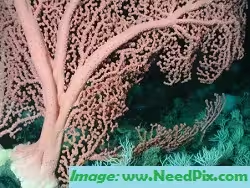Bubblegum Corals
Bubblegum Corals are large corals in bright colors that remind us of bubblegums. They are habitat creators, meaning they make the place liveable for other marine organisms. They are an important feature of coral forests in non-tropical seas.

Bubblegum Corals are found in sloping coral reefs. They are common in the coral reefs of North Pacific and North Atlantic oceans.
Foundation species
Bubblegum coral is a foundation species. Algae, fishes and small corals enjoy living around them. They provide a habitat for smaller species. Foundation species are animals and plants that support other plants and animals.
Description
They are made of many tiny buds (that look like wads of bubblegum). Each bud ,called a polyp, is an animal with eight small tentacles.
Groups of them bunch together forming colonies. A coral is made of many colonies together.
A group can live for more than hundred years. Bubblegum corals are huge, growing to heights of 2 storey buildings.
How they feed
At night, when the tide comes in, polyps spread out their tentacles to catch planktons drifting in the water. Tentacles act like filters to trap planktons. Many marine organisms feed on planktons by filtering them. They are called filter feeders.
Why are Bubblegum Corals vulnerable
Bubblegum corals need temperatures between 3 and 8 C (37 F and 46 F). They cannot live in freezing temperatures. They cannot survive warm tropical waters too. As sea temperatures raise due to global warming, bubblegum corals are at risk. Commercial fishing, Deep sea mining and other human activities also inflich damage on this fragile coral.
Protecting Bubblegum corals is important to conserve coral reefs and protect smaller species of marine life.
